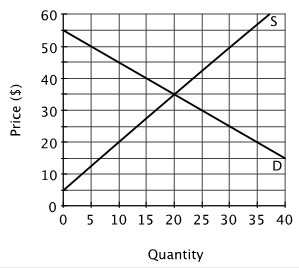Consumer surplus
a. is the difference between total willingness to pay and the total amount actually paid.
b. guarantees that the market value of a good in money is equal to the total economic value of the good.
c. is always negative because of diminishing marginal utility.
d. is the total area under a consumer's demand curve.
A
You might also like to view...
Refer to the figure below. The equilibrium price is ________, and the equilibrium quantity is ________. 
A. $30; 15 B. $35; 20 C. $25; 5 D. $25; 20
The Congressional Budget Office estimates that the additional taxes and fees enacted under the ACA will not even cover half of the true cost of the ACA
Indicate whether the statement is true or false
The Board of Governors of the Fed:
A. consists of seven state governors who represent the views of individual states in monetary policy. B. consists of seven members appointed by the President of the United States, who together act as the key decision-making entity for monetary policy. C. consists of 13 large commercial bank CEOs who represent the interests of the private banking sector in monetary policy. D. is the primary monetary group responsible for buying and selling bonds designed to change reserves in the banking system. The Board of Governors is the key decision maker for monetary policy.
If two nations both peg to a center nation, and one devalues its exchange rate against the other partner (noncooperatively) and to the center as a result of a demand shock, what is the effect?
A) The center nation will require that the two line up their rates. B) The devaluing nation will see an increase in demand while the other partner sees a decrease (thus sharing the effect of the demand shock). C) The devaluing nation will devalue more steeply and will see a larger increase in demand while its partner will suffer more (thus favoring the devaluing nation). D) Both nations will suffer more because the center nation will match the devaluation, thus negating the effect.